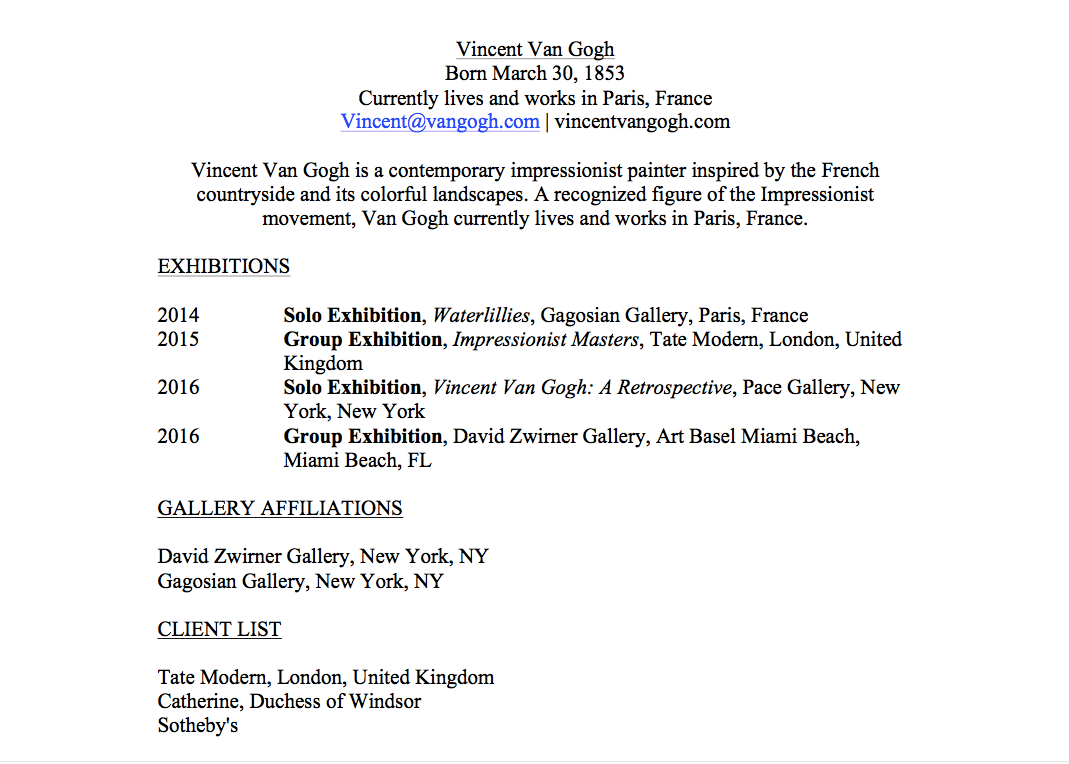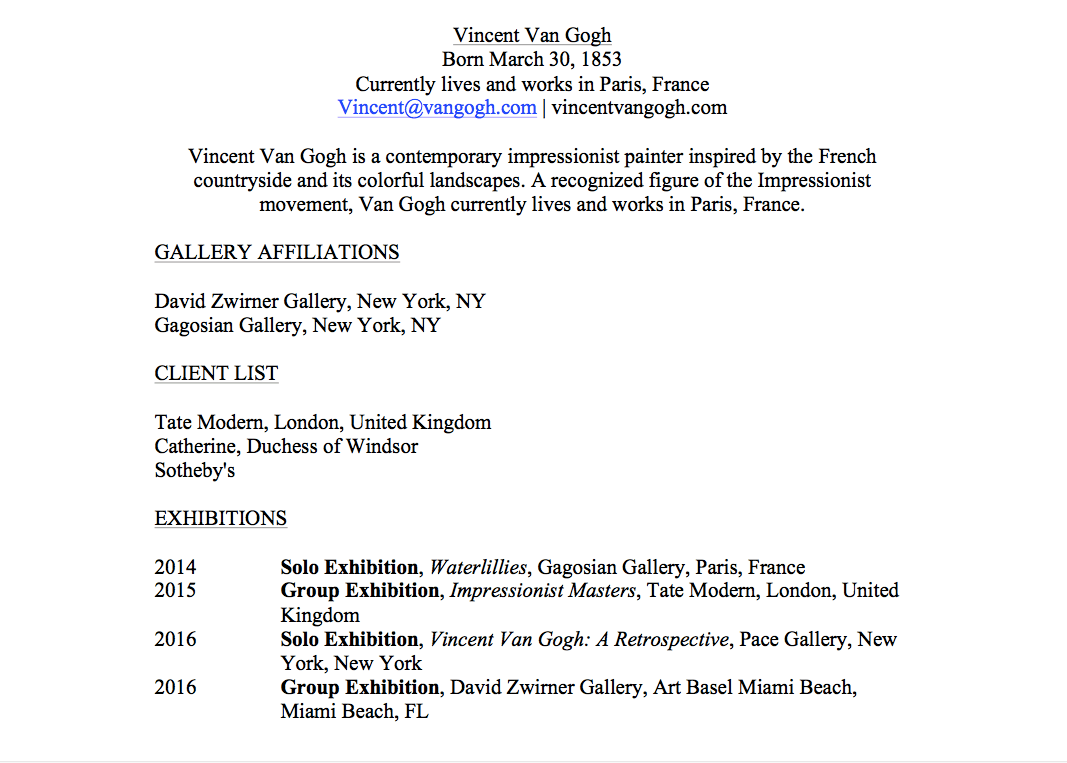As a creative, you’ve learned to make meaningful personal statements through your work. But as a professional, how do you effectively connect with someone about your career? Regardless of whether it’s on paper or through a screen, a strong artist resume or CV is a critical tool when it comes to networking and professional advancement.They just happen to look a little different, which is why we’re going to break it down step by step.
How an Artist Resume Differs
Most of us have some familiarity with resumes, a document that’s required whenever you apply for a job, graduate school, or artist residency. Typically reflective of our professional experience, we often think they’re most important when we’re pursuing a specific position – and that, as an artist, we may not have a need for such corporate documents. An artist resume, however, remains an important way to tell your story, connect with a larger audience, and, hopefully, make a profound impact on future decision makers.
Galleries, museums, and art fairs are inundated with talent, making it crucial that you have the proper materials to substantiate your experience and vision. It’s also important when it comes to winning over potential patrons, who will be invested in your growth as an artist before deciding whether or not they’re willing to invest in your work.
Brian Swarts, president of Taglialatella Galleries,, explains, “It’s important for collectors to have a historical backup of museums and collections that an artist belongs to give collectors history and some comfort in what they’re buying. They want to make certain that the artist is investable and that the work isn’t just a painting on a wall by someone never to be heard from again.”
Your formal education, involvement in residencies, shows and exhibitions, and even the awards you’ve received allow people to form an idea about the potential value of your work, ultimately influencing their decision to invest in your career. So even if you have the luxury of spending your days in front of the canvas, an impactful artist CV is an absolute must-have if you’re interested in developing relationships with art collectors.
Much like how traditional resumes are tailored to highlight certain skills or achievements for specific audiences, your artist resume should also be considered a living document. Are you reaching out to a top tier gallery? Then you’ll want to lead with your most noteworthy exhibitions. Hoping to be accepted to a prestigious artist residency? Then you’ll want to lean into your educational experience.
Crafting Your Artist Resume
Here’s the nice news: instead of adhering to the structure of a more corporate document, your artist resume functions as a concise list of where you’ve exhibited and been collected rather than on your work experience. It paints a picture of your professional journey as an artist and shows creative growth and development. And while it can be easy to want to embellish, we implore you: don’t. Just be honest about your education, professional accomplishments, awards, and any press that you’ve received. =
Be sure that you’re writing in the third person and start with an artist bio, including details like where you’re from, where you currently live, your medium and style, and perhaps even your greatest strengths. Remember: this is not the time for exaggeration, and you want to present an honest account of your artistic experience. You’ll also want to present yourself as a professional, so be sure to avoid any amateur sounding email addresses and remember to include links to your portfolio.
Next, there are some key areas to include – but only if you have the appropriate information. If you’re unable to speak to some of these points for lack of experience, that’s absolutely fine. Just leave them out for now.
- Personal details: Name, contact information (email address, address, phone number)
- Artist statement: A thoughtful description of your work and why you create. Read more about crafting the perfect artist statement.
- Education: Where you received your bachelor’s degree and any postgraduate degrees
- Exhibitions: Where you’ve exhibited, starting with the most recent shows
- Bibliography: Where your work has been written about
- Collections: A list of any public institutions that own your art
- Publications: A list of where you’ve published arts-related writing
- Teaching: A list of where you’ve served as an adjunct professor or instructor
- Curatorial projects: A list of shows you’ve curated, including your own
- Awards and Grants: A list of the organizations that have awarded you recognition (don’t skimp on the details!)
- Residencies: Including when and where, and what your focus was
Structuring Your Resume
Here’s where things are admittedly a little more tricky, but easy to overcome once you understand the intention behind your artist resume. Just as you would for any other job or opportunity, how you organize the information is entirely based upon what you’re pursuing. To revisit Swarts’ earlier comments, galleries are most interested in where an artist has exhibited and whether or not they’ve sold. “For us, it’s more about having some depth to an artist’s experience,” he explains. “Has the artist been at art fairs, shown at other galleries? Have they exhibited somewhere that carries a big name? I’m much more interested in where they’ve shown and what their marketplace is, rather than their educational background.” Interestingly, Swarts notes that collectors have their own wish list when it comes to a resume or CV. “For collectors, they mostly want to hear that they’ve been at a museum or auction house.”
These hints are invaluable when it comes to how you approach your layout. Are you sending your work to a gallery? Then you know to start by mentioning past exhibitions and art fairs. Are you appealing directly to a collector? Then you can place more emphasis on museum collections or auction house sales.
Let’s take a look at how we might structure an artist resume targeting a gallery:

As always, we start with basic information such as the artist’s name, location, and contact information, followed by the artist statement. Then, we implement our strategy: leading with the artist’s exhibition history to appeal to galleries and institutions.
But what if you want to appeal to collectors directly? As discussed, the structure would be altered to reflect their needs:

Just as before, you’ll need to lead with the basics. However, clients and galleries are prioritized and listed above any exhibitions – because that’s the information that private collectors are most interested in.
If you’re an emerging artist and still building your roster of exhibitions and fairs, don’t worry: we all start somewhere! Just lead with your educational background and be sure to mention any shows or projects that you’ve organized.
Consider Adding Visuals to Your Artist Resume
You’re in a visual business. Don’t be afraid to, quite literally, “illustrate” your accomplishments! If you’ve had some major wins being featured in an exhibition or a private or corporate collection, adding visual evidence is a powerful way to distinguish the importance of your contribution.
For digital artist resumes, you can explore how to attach a portfolio that specifically highlights your experiences (just be sure that they are clearly labeled). Or, if you’re approaching things the old fashioned way, consider organizing your visual examples as a supportive document – just remember, as before, to identify what people are looking at.
It can feel unglamorous, cumbersome, and even confusing at first, but the reality is that taking the time to understand how to properly format and write a resume can open doors and catapult your career. Just remember to keep it up to date: we’re sure fantastic new opportunities are about to start knocking at your door.
Have you crafted your own artist resume, or are you planning to create one? Share your experiences, challenges, or any tips you’ve found helpful in the comments below.
